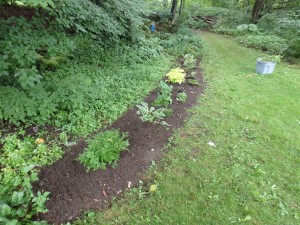Have Patience: Good Gardens Take Time
One of the things I have learned over the years is that a garden needs time to develop and reach its full glory. The late children’s book author and illustrator – and gardener extraordinaire – Tasha Tudor once told me, “You need patience. It takes twelve years to make a garden. Everything that’s worthwhile takes time.” That seems a bit too long, but it does take time – years, in fact.
Recently I’ve been working on a shade garden that needed a pick-me-up. It has always been great in the spring with daffodils, snowdrops and scilla. There are lots of wild flowers and perennials, too, starting with hellebores that blossom beginning in late March and that have glossy dark green leaves all summer. Then come the primroses, anemones, Brunneras and finally hostas. All are green and pleasant now, but not dramatic. There wasn’t enough contrast for my taste. I have lots of groundcover – spotted dead nettle, or Lamium maculatum – that provided green and white foliage – but it’s somewhat boring right now.
So I created a new 3-foot wide curved bed about 30 feet long that replaces some of that ground cover and adds life to the wider garden area behind it.
I started by preparing the soil. It’s a shade garden, which means that there are a lot of tree roots in the space I wanted to plant. I defined the new bed by stretching out a garden hose defining a gentle curve. Using a pointed spade, I cut a sharp line into the soil 8 inches deep all along the hose, and then parallel to that 3 feet back from it.
Next I used a 4-tined weeding fork to pull the ground cover from the soil. This is a nice Italian tool made in a factory that has been making them the same way for generations. I got mine from Howland Tools in Shelburne Falls. MA (http://www.howlandtools.com). The curved12-inch long tines comb through the soil, finding and lifting roots. It’s like a 4-tined rake with extremely long tines. Some also call it a potato fork.
Tree roots were plentiful in my new bed so much of the soil’s fertility had been taken up long ago. The trees also suck water out of the soil, so removing roots helps in the short term (though I know they will return). I added organic slow-release fertilizer (one called Pro-Gro) and lots of compost – a couple of inches of it everywhere. I mixed it into the soil with that weeding fork, and then watered it repeatedly. Extra dry soil takes a long time to absorb water.
Since I like to plant according to the cycles of the moon, planets and stars, I consulted my Stella Natura calendar (www.stellanautra.com) and waited for a day auspicious for planting flowers. As it turned out, that was also a rainy day – the first in a long time here.
So what did I plant? In the middle I planted a perennial known as spikenard or Aralia cordata, one called ‘Sun King’. It gets to be a big plant, maybe 3 feet tall and wide, and has brilliant yellow-green leaves and does well in shade or part shade. Nearest the spikenard I wanted contrasting foliage, so I planted a black-leafed bugleweed (Ajuga reptens ‘Black Scallop’) and a glossy, dark green-leafed European wild ginger (Asarum europaeum).
Other plants I dug up and moved there were barrenwort (Epimedium spp.), two sizes of goatsbeard (Aruncus spp.) and a medium-sized green and white hosta. All were plants I had elsewhere. I matched the planting so that each side of the gardenwas a mirror image of the other – or as much as one can do with plants.
I spaced the plants based on how big they will be in 3 years. That means 2 or 3 feet apart for full-sized perennials. Of course that means the garden looked a little sparse when first planted, so I got a few annuals to fill in. I also planted some forget-me-not (Myosotis sylvatica) to transplant into empty spaces. That’s an annual or biennial with early spring blue flowers that grows everywhere in my gardens, hundreds of them. Thousands, perhaps. It’s a great filler.
The day after planting my flowers I went up to E.C. Brown Nursery in Thetford, Vermont to see about some shrubs to add to the mix. I got two pagoda dogwoods (Cornus alternifolia) to plant behind the newly planted border. Pagoda dogwood grows well for me –it’s a native shrub that often pops up in shady places.
Why did I need to buy two more? They had some with variegated-leafed specimens with green and white leaves. Leaves with some white look good in dark, shady places. These understory trees are small, and will take 4 or 5 years to get to a size where they’re dramatic. But that just goes back to what Tasha Tudor told me: Everything that’s worthwhile takes time. And maybe she’s right, maybe I’ll still be tweaking plantings in thisgarden for the next 12 years.
Henry is the author of 4 gardening books. Read his twice-weekly blog posts and see lots of photos by going to https://dailyuv.com/gardeningg



